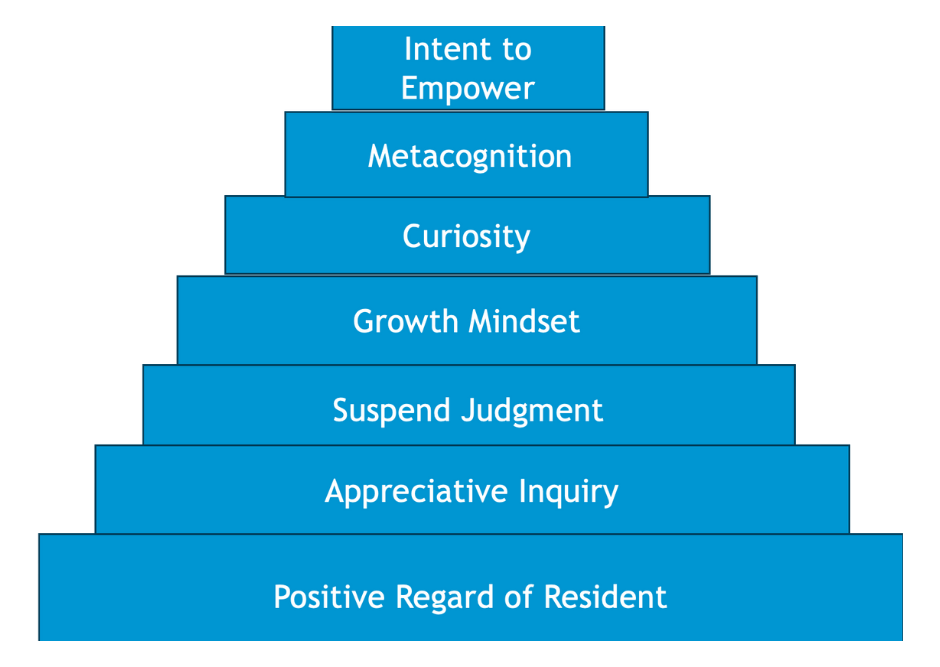
The Adaptive Coaching Spectrum: Becoming a Master Adaptive Faculty
This post is part of the Faculty Coaching Skills Series, which explores how faculty can apply coaching approaches in medical education.
If you’ve followed this series, you’ve seen the throughline: coaching isn’t a single skill set, it’s a mindset and a conversational approach that shapes how we teach, guide, and connect.
I hope this post ties it all together: how faculty flex across the Adaptive Coaching Spectrum, and how our own foundational mindsets act as guardrails, helping us build rapport, show up at our best, and know when to lean more directive or more curious.
The Adaptive Coaching Spectrum
Imagine a continuum stretching from Directive (Teaching / Advising) on the far left to Developmental (Professional Coaching) on the far right.

Most faculty work in the dynamic middle, what I term the Co-Creation Zone, where both parties bring expertise, reflection, and curiosity to the conversation.
The artistry lies in knowing when to flex:
-
When to guide and clarify.
-
When to listen and draw out.
-
When to do both, gracefully, in real time.
The Mindset Guardrails: Foundation of the Master Adaptive Faculty
Before deciding where to land on the spectrum, it’s worth looking inward.
The Master Adaptive Faculty mindset is what steadies you as you shift left or right. These aren’t steps or stages, they’re guardrails that help you bring your best self to every coaching moment.

The Mindsets That Anchor Faculty Coaching:
Positive Regard of Resident. See the learner as whole, capabile, and resourceful. This keeps you from being too directive, too soon. And it allows you to use your appreciative inquiry lens toward them. Appreciative Inquiry What’s going well? That allows you to Suspend Judgment.
Suspend Judgment – Keep your clinical and educator judgment active, but not aimed at the learner’s character or capacity. Use discernment without defining them. Think Judgment not Judmentalism. And that will really allow you to have your own growth mindset toward them.
Growth Mindset – Treat gaps as data, not necessarily deficiency. These are their opportunities to grow. This is why we have residency training. And that allows for you to fully be Curious.
Curiosity - Cultivate reflective awareness in yourself - curiosity about the person (not the problem per se). And that curiousity leads you to think and see how they are thinking. Your own Metacognition. Metacognition –understanding that allows you to
Empower them and fill the gaps with your expertise as needed.
In Service of Resident. When we remind ourselves that coaching is in service of the resident, it helps us show up differently. We can stay curious just a little bit longer (nod to MBS), realign with the educational alliance, and focus on their growth - which is actually freeing, encouraging, and rewarding for us as well.
These mindsets set the tone for how we show up. From there, the context helps us decide how far to lean into structure or curiosity when to slide left or right on the co-creation zone coaching spectrum.
Context Cues
Lean left (directive, expert-driven) when:
-
The situation is safety-critical or time-pressured.
-
The learner is novice or unsure of next steps.
-
The program requires defined outcomes or remediation.
-
It feels like a fire drill.
Lean right (developmental, reflective) when:
-
The topic is identity, mindset, wellbeing, motivation or other developmental topic.
-
The learner already knows what to do but needs to clarify why or how.
-
The goal is growth or self-direction, not correction.
Bandwidth Cues
When either you or the resident is showing signs of low bandwidth (fatigue, stress, limited time or focus) it’s often best to lean left.
Keep the conversation concrete and brief: clarify expectations, offer specific guidance, and defer deeper reflection to a later time.
A quick bridge question can still preserve agency:
“I can share what I’d do here, but would you like a moment to think through your reasoning first?”
That small pause honors both efficiency and ownership.
Rapport Cues
When rapport is low or the relationship is new, start a bit more structured, but not fully directive.
A light coaching stance can actually build trust. Begin with curiosity and shared purpose. Connect before content.
Try framing with gentle permission:
“Would it be helpful if I asked a question to help you think through this, or are you looking for my take right now?”
This shows respect for the learner’s autonomy and lowers defensiveness.
I will say that sometimes coach/learner pairs just aren’t a good match, or for a season they may not be, so reassigning who is coaching those developmental topics sometimes may be in order.
Role Cues (Hat Switch)
Faculty are rarely wearing a formal coach hat, unless certified and designated as internal coaches.
Most of the time, you’re integrating coaching skills within your existing faculty roles.
When two roles overlap - say, combining an advisor meeting with an ILP coaching conversation, name the transition explicitly:
“I’m going to step into my advisor role for a moment.”
“Okay, back to our ILP coaching conversation.”
Naming the hat signals intent and protects psychological safety
Closing Thoughts
Faculty coaching isn’t about mastering one stance. It’s about knowing yourself well enough to flex intentionally.
When you lead from curiosity, positive regard and a growth mindset, you naturally model what we hope residents will become: self-aware, adaptive, and resilient learners.
That’s the mark of a Master Adaptive Faculty, one who shows up in service of learning.
One who recognizes that coaching and teaching aren’t opposites, they’re two lenses, and the wisdom lies in knowing which one to look through next. You build that intuition over time. You've got this!
Join Weekend Reads
Weekly insights, tips, and tools for physicians who want to thrive—plus a dash of fun.
We hate SPAM. We will never sell your information, for any reason.

